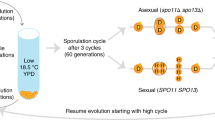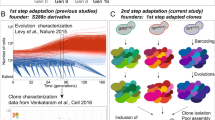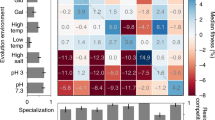Abstract
Adaptive mutations are shown to have a higher frequency of fixation in evolving diploid than in haploid populations of the yeast Saccharomyces cerevisiae, providing direct evidence that it may be an evolutionary advantage to be diploid.
This is a preview of subscription content, access via your institution
Access options
Subscribe to this journal
Receive 51 print issues and online access
$199.00 per year
only $3.90 per issue
Buy this article
- Purchase on Springer Link
- Instant access to full article PDF
Prices may be subject to local taxes which are calculated during checkout
Similar content being viewed by others
References
Williams, G. C. Sex and Evolution (Princeton University Press, 1975).
Maynard Smith, J. The Evolution of Sex (Cambridge University Press, 1978).
Svedelius, N. Proc. int. Congr. Pl. Sci. Ithaca, N.Y. 1, 457–471 (1929).
Stebbins, G. L. Variation and Evolution in Plants (Columbia University Press, 1950).
Crow, J. F. & Kimura, M. Am. Nat. 99, 439–450 (1965).
Adams, J. & Mansche, P. E. Genetics 76, 327–338 (1974).
Lewontin, R. C. The Genetic Basis of Evolutionary Change (Columbia University Press, 1974).
Crow, J. F. & Kimura, M. An Introduction to Population Genetics Theory (Harper & Row, New York, 1970).
Weiss, R. L., Kukora, J. R. & Adams, J. Proc. natn. Acad. Sci. U.S.A. 72, 794–798 (1975).
Muller, H. J. Am. Nat. 8, 118–138 (1932).
Sonneborn, T. M. in The Biology of Aging (eds Behnke, J. A., Finch, C. E. & Moment, G. B.) 361–374 (Plenum, New York, 1978).
Bernstein, H., Beyers, G. & Michod, R. Am. Nat. 117, 537–549 (1981).
King, J. L. & Jukes, T. H. Science 164, 788–798 (1969).
Kimura, M. & Ohta, T. J. molec. Evol. 1, 1–17 (1971).
Drake, J. W. in Evolution in the Microbial World (eds Carlile, M. J. & Skehel, J. J.) 41–58 (Cambridge University Press, 1974).
Huxley, J. Evolution: The Modern Synthesis (Alien & Unwin, London, 1942).
Dayhoff, M. O. Atlas of Protein Sequence and Structure Vol. 5 (National Biomedical Research Council, Silver Spring, Maryland, 1972).
Jensen, R. A. A. Rev. Microbiol. 30, 409–425 (1976).
McIntyre, R. J. A. Rev. Ecol. Syst. 7, 421–468 (1976).
Hood, L., Campbell, J. H. & Elgin, S. C. R. A. Rev. Genet. 9, 305–323 (1975).
Ohno, S. Evolution by Gene Duplication (Springer, Berlin, 1970).
Lindsley, D. L. & Grell, E. H. Carnegie Inst. Wash. Publ. 627 (Washington D.C., 1968).
McKusick, V. A. & Chase, G. A. A. Rev. Genet. 7, 435–473 (1973).
Koch, A. L. Genetics 77, 127–142 (1974).
Atwood, K., Schneider, L. & Ryan, F. J. Cold Spring Harb. Symp. quant. Biol. 16, 345–355 (1951).
Maynard Smith, J. & Haigh, J. Genet. Res. 23, 23–35 (1974).
Kubitschek, H. R. in Evolution in the Microbial World (eds Carlile, M. J. & Skehel, J. J.) 105–130 (Cambridge University Press, 1974).
Paquin, C. E. & Adams, J. Curr. Genet. 6, 21–24 (1982).
Lindegren, B. W. Statistical Theory (Macmillan, New York, 1976).
Novick, A. & Szilard, L. Proc. natn. Acad. Sci. U.S.A. 36, 708–719 (1950).
Novick, A. in Perspectives in Marine Biology (ed. Buzzati-Traverso, A. A.) 533–547 (University of California Press, 1960).
Thorne, R. S. W. J. Inst. Brew. 74, 516–524 (1968).
Thorne, R. S. W. J. Inst. Brew. 76, 555–563 (1970).
Valenzuela, P., Medina, A., Rutter, W. J., Ammerer, G. & Hall, B. D. Nature 298, 347–350 (1982).
Timmis, K. N. et al. Molec. gen. Genet. 167, 11–19 (1978).
Adams, J., Kinney, T., Thompson, S., Rubin, L. & Helling, R. B. Genetics 91, 627–637 (1979).
Isaacs, J. in Perspectives in Marine Biology (ed. Buzzati-Traverso, A. A.) 545 (University of California Press, 1960).
Paquin, C. thesis, Univ. Michigan (1982).
Holland, J. et al. Science 215, 1577–1585 (1982).
Gibson, T. C., Scheppe, M. L. & Cox, E. C. Science 169, 686–688 (1970).
Nestmann, E. R. & Hill, R. F. Genet. Suppl. 73, 41–44 (1973).
Nestmann, E. R. & Hill, R. F. J. Bact. 119, 33–35 (1974).
Painter, P. R. Genetics 79, 649–660 (1975).
Kimura, M. Genet. Res. 9, 25–34 (1967).
Eshel, I. Theor. Populat. Biol. 4, 196–208 (1973).
Leigh, E. Genet. Suppl. 73, 1–18 (1973).
Darlington, C. D. The Evolution of Genetic Systems 2nd edn (Basic Books, New York, 1958).
Fowell, R. R. in The Yeasts Vol. 1 (eds Rose, A. H. & Harrision, J. S.) 461–471 (Academic, New York, 1969).
Lewis, J. & Wolpert, L. J. theor. Biol. 78, 425–438 (1979).
Van Uden, N. & Fell, J. W. Adv. Microbiol. Sea 1, 167–202 (1968).
Roman, H., Phillips, M. M. & Sands, S. M. Genetics 40, 546–561 (1955).
Helling, R. B., Kinney, T. & Adams, J. J. gen. Microbiol. 123, 129–141 (1981).
Magni, G. & Von Borstel, R. Genetics 47, 1097–1108 (1962).
Lea, D. & Coulson, A. J. Genet. 49, 264–285 (1949).
Wilkie, D. & Lee, B. K. Genet. Res. 6, 130–138 (1965).
Francis, J. C. & Hansche, P. E. Genetics 70, 59–73 (1972).
Broach, J. R. in The Molecular Biology of the Yeast Saccharomyces I, 653–727 (Cold Spring Harbor Laboratory, New York, 1982).
Kubitschek, H. E. Introduction to Research with Continuous Cultures (Prentice-Hall, New Jersey, 1970).
Gottlieb, D. & Von Borstel, R. Genetics 83, 655–666 (1982).
Author information
Authors and Affiliations
Rights and permissions
About this article
Cite this article
Paquin, C., Adams, J. Frequency of fixation of adaptive mutations is higher in evolving diploid than haploid yeast populations. Nature 302, 495–500 (1983). https://doi.org/10.1038/302495a0
Received:
Accepted:
Published:
Issue Date:
DOI: https://doi.org/10.1038/302495a0
This article is cited by
-
Identifying Targets of Selection in Laboratory Evolution Experiments
Journal of Molecular Evolution (2023)
-
Ploidy Identification by Flow Cytometry and Application of the Method to Characterize Seasonal Ploidy Variation of Wild Populations of the Red Alga Gracilariopsis lemaneiformis
Marine Biotechnology (2022)
-
Evolutionary engineering to improve Wickerhamomyces subpelliculosus and Kazachstania gamospora for baking
World Journal of Microbiology and Biotechnology (2022)
-
Current advances in haploid stem cells
Protein & Cell (2020)
-
Altered access to beneficial mutations slows adaptation and biases fixed mutations in diploids
Nature Ecology & Evolution (2018)
Comments
By submitting a comment you agree to abide by our Terms and Community Guidelines. If you find something abusive or that does not comply with our terms or guidelines please flag it as inappropriate.



